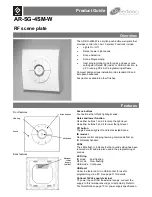
13
NeoFace Access Control User's Guide
Table
Disposal
NeoFace and auxiliary storage media
When discarding NeoFace and auxiliary storage media (SSD etc.), please contact your sales representative. Customers should
ensure that the data stored in the auxiliary storage media cannot be restored, reproduced, or reused by a third party before
disposing the media, and take adequate precautions to protect personal privacy and corporate confidential information.
- AC adapter and power cord
Please discard the optional AC adapter and power cord along with NeoFace to prevent diversion to other equipment.
- Lithium battery
Lithium batteries have been used in NeoFace. Placing the battery close to a fire or in the water may cause an explosion. When
NeoFace does not operate properly because the lithium battery is dead, contact your sales representative without disassembling,
replacing or charging the battery.
Privacy Policy
Please do not keep my number information in information processing terminals such as computers connected to NeoFace. If such
information is discovered, providing maintenance support may not be possible.
Federal Communication Commission Interference Statement
This device complies with Part 15 of the FCC Rules. Operation is subject to the following two conditions: (1) This device may not
cause harmful interference, and (2) this device must accept any interference received, including interference that may cause undesired
operation.
This equipment has been tested and found to comply with the limits for a Class B digital device, pursuant to Part 15 of the FCC Rules.
These limits are designed to provide reasonable protection against harmful interference in a residential installation. This equipment
generates, uses and can radiate radio frequency energy and, if not installed and used in accordance with the instructions, may cause
harmful interference to radio communications. However, there is no guarantee that interference will not occur in a particular
installation. If this equipment does cause harmful interference to radio or television reception, which can be determined by turning the
equipment off and on, the user is encouraged to try to correct the interference by one of the following measures:
•
Reorient or relocate the receiving antenna.
•
Increase the separation between the equipment and receiver.
•
Connect the equipment into an outlet on a circuit different from that to which the receiver is connected.
•
Consult the dealer or an experienced radio/TV technician for help.
FCC Caution:
•
Any changes or modifications not expressly approved by the party responsible for compliance could void the user's authority to
operate this equipment.
•
This transmitter must not be co-located or operating in conjunction with any other antenna or transmitter.
Industry Canada statement
This device complies with Industry Canada license-exempt RSS standard(s). Operation is subject to the following two conditions:
1)
this device may not cause interference, and
2)
this device must accept any interference, including interference that may cause undesired operation of the device.
Le présent appareil est conforme aux CNR d'Industrie Canada applicables aux appareils radio exempts de licence. L'exploitation est
autorisée aux deux conditions suivantes:
1)
l'appareil ne doit pas produire de brouillage, et
2)
l'utilisateur de l'appareil doit accepter tout brouillage radioélectrique subi, même si le brouillage est susceptible d'en
compromettre le fonctionnement.
This Class B digital apparatus complies with Canadian ICES-003.
Cet appareil numérique de la classe B est conforme à la norme NMB-003 du Canada.
This device and its antenna(s) must not be co-located or operating in conjunction with any other antenna or transmitter,
except tested built-in radios.
Cet appareil et son antenne ne doivent pas être situés ou fonctionner en conjonction avec une autre antenne ou un autre émetteur,
exception faites des radios intégrées qui ont été testées.














































